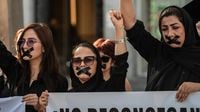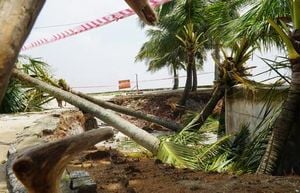Four years have passed since the Taliban swept back into power in Afghanistan, but for millions of Afghan women and girls, time seems to have stood still. As the world’s attention drifts elsewhere, the daily realities for women—both inside Afghanistan and in exile—have only grown more dire. Reports from the United Nations and first-person accounts collected by The Media Line paint a picture of escalating hardship, lost futures, and a generation caught between persecution at home and despair abroad.
On August 17, 2025, the United Nations Women’s Section released a sobering report on its X page, warning that approximately 78 percent of young women and girls in Afghanistan are now denied access to school, employment, and technical education—a rate four times higher than that for boys. The report, published almost exactly four years after the Taliban’s return to power, underscores how the group’s sweeping restrictions have threatened the health, education, and security of Afghan women, with consequences that echo far beyond the country’s borders.
The Taliban’s seizure of power on August 15, 2021, marked a dramatic turning point. As US-led forces withdrew and the Afghan government collapsed, thousands of desperate citizens rushed to the airport, hoping for evacuation. Many, especially women, were left behind as the Taliban swiftly reestablished control. According to The Media Line, the group wasted no time in imposing its interpretation of Islamic law, which has included banning most women from working with aid agencies, shutting down beauty salons, restricting access to public spaces, and—perhaps most devastatingly—barring girls above the sixth grade from attending school.
Today, UN estimates suggest that 2.2 million Afghan girls are denied education, with projections that this number could double by 2030 if current restrictions persist. The United Nations report further notes that these gender-based barriers extend to healthcare; many women are now forced to travel long distances to access clinics, with some services simply out of reach. The consequences are stark: increased maternal mortality, a surge in child marriage, psychological crises, and deepening poverty among families.
The statistics are grim. By 2026, early pregnancies are projected to rise by 45 percent, and maternal mortality is expected to increase by more than 50 percent. In 2023 alone, about 30 percent of Afghan girls under 18—including 10 percent under 15—were married, often as families, driven by poverty, saw little alternative but to marry off their daughters. “Restrictions on women’s movement, prohibitions on medical education, and gender-based barriers have forced many women to travel long distances to access clinics, with some services remaining out of their reach,” the UN Women’s Section reported.
But the crisis doesn’t end at Afghanistan’s borders. The Media Line has spoken to Afghan women in exile who describe a double bind: persecuted at home, but unwelcome abroad. Since the Taliban’s return, millions of Afghans—most of them women and children—have fled, seeking safety in neighboring Iran and Pakistan. Yet, in these host countries, refugees face discrimination, legal barriers, and the ever-present threat of deportation. Forced migration, once seen as a last hope, has become another form of confinement.
“The world talks about human rights in Afghanistan, but for us, it feels like we’ve been left to vanish quietly,” said Mariam Sadat, a women’s rights advocate who spoke to The Media Line. Sadat recounted the chaos of Kabul’s fall as if it happened yesterday: “It feels like I never escaped August 2021. I’m still there—trapped in that month. Every day since has been the same August repeating itself.” Her memories are haunted by the violence and fear of that time: “The memories come back in rubbles, bodies crushed against mine, the deafening chaos of gunfire, and the haunting image of people collapsing, shot down only steps away.”
For Sadat and many others, exile has not brought freedom or healing—only a different kind of prison. Shumaila Karimi, another Afghan woman interviewed by The Media Line, described being beaten during anti-Taliban protests and fleeing with her family first to Iran, then to Pakistan. “With immense fear and anxiety, my family and I managed to reach Iran. With no institution or organization in Iran listening to our voices—and even the United Nations remaining unresponsive—we once again, full of worry and uncertainty, made our way to Pakistan on a friend’s advice,” Karimi said. Her family’s ordeal didn’t end there; they lost their father and now live “in the same uncertainty, hopelessness, and constant fear of being deported. Exile has not brought freedom for us—it has brought another kind of confinement, marked by poverty, fear, and endless waiting.”
Maryam, a 26-year-old university graduate from Kabul, once led student demonstrations and sang revolutionary songs. Now, she lives in hiding in Pakistan. “I had one small suitcase,” she told The Media Line. “I left behind my books, my friends, my parents. I left my voice. Here, I live like a shadow, afraid of the police, afraid of deportation. In Afghanistan, the Taliban tried to erase us. In exile, the world has forgotten us.”
Aid organizations have stepped in where they can, but the needs far outstrip the resources available. Rebecca Trotter, executive director of Food for Thought Afghanistan, told The Media Line that her group recently relocated 60 Afghan women and their families from Islamabad to Brazil. “These women were on the verge of being handed back to the Taliban, where their fate would have been sealed with death sentences,” Trotter said. “We gave them hope where there was only despair—this was far more than a rescue mission.” She emphasized that many Afghan women in Iran and Pakistan remain without legal status and at constant risk of harassment, exploitation, and deportation.
Meanwhile, Western governments face a painful dilemma. Jordan Kane, a Washington-based expert on fragile states, told The Media Line that aid is one of the few tools left to influence the Taliban. But cutting aid to pressure the regime could make things even worse. “Aid cuts by the US and other donors may weaken the Taliban’s grip on power, but only at a truly awful human cost,” Kane said, noting that women and children are most vulnerable to food shortages, poverty, and failing public services. She also pointed out that aid diversion by the Taliban is troubling, but not unprecedented in conflict zones.
The long-term outlook for Afghanistan’s women remains bleak. Najeeb Azad, a political analyst and former spokesperson for ex-President Ashraf Ghani, told The Media Line that the Taliban’s rule has left the country’s younger generation unprepared for the global economy. He argued that the West has often prioritized strategic interests over Afghan human rights. Azad also questioned the durability of Taliban rule, observing that “the Taliban’s rule is unlikely to endure unless the United States and its allies choose to sustain it for geopolitical purposes—a choice increasingly at odds with realities on the ground.”
For now, Afghan women—whether still in the country or scattered in exile—continue to plead for recognition, education, and safety. Their voices, though too often unheard, remind the world that the struggle for basic rights is far from over, and that the cost of neglect is measured in lost lives and broken futures.




